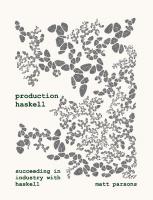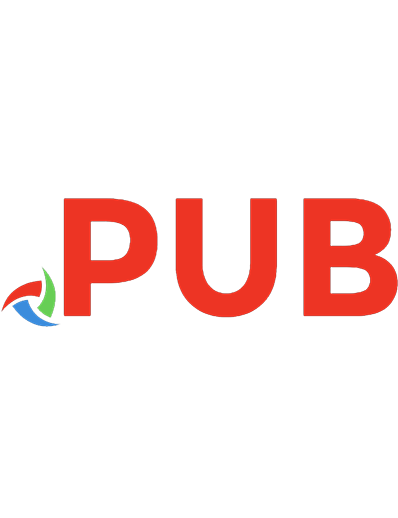Programming in Haskell [Second Edition, 5th printing.] 9781316626221, 1316626229
Added bookmarks over the previous PDF version on libgen
754 150 6MB
English Pages [320] Year 2018
Table of contents :
Foreword
Preface
Part I. Basic Concepts
1 Introduction
1.1 Functions
1.2 Functional programming
1.3 Features of Haskell
1.4 Historical background
1.5 A taste of Haskell
1.6 Chapter remarks
1.7 Exercises
2 First steps
2.1 Glasgow Haskell Compiler
2.2 Installing and starting
2.3 Standard prelude
2.4 Function application
2.5 Haskell scripts
2.6 Chapter remarks
2.7 Exercises
3 Types and classes
3.1 Basic concepts
3.2 Basic types
3.3 List types
3.4 Tuple types
3.5 Function types
3.6 Curried functions
3.7 Polymorphic types
3.8 Overloaded types
3.9 Basic classes
3.10 Chapter remarks
3.11 Exercises
4 Defining functions
4.1 New from old
4.2 Conditional expressions
4.3 Guarded equations
4.4 Pattern matching
4.5 Lambda expressions
4.6 Operator sections
4.7 Chapter remarks
4.8 Exercises
5 List comprehensions
5.1 Basic concepts
5.2 Guards
5.3 The zip function
5.4 String comprehensions
5.5 The Caesar cipher
5.6 Chapter remarks
5.7 Exercises
6 Recursive functions
6.1 Basic concepts
6.2 Recursion on lists
6.3 Multiple arguments
6.4 Multiple recursion
6.5 Mutual recursion
6.6 Advice on recursion
6.7 Chapter remarks
6.8 Exercises
7 Higher-order functions
7.1 Basic concepts
7.2 Processing lists
7.3 The foldr function
7.4 The foldl function
7.5 The composition operator
7.6 Binary string transmitter
7.7 Voting algorithms
7.8 Chapter remarks
7.9 Exercises
8 Declaring types and classes
8.1 Type declarations
8.2 Data declarations
8.3 Newtype declarations
8.4 Recursive types
8.5 Class and instance declarations
8.6 Tautology checker
8.7 Abstract machine
8.8 Chapter remarks
8.9 Exercises
9 The countdown problem
9.1 Introduction
9.2 Arithmetic operators
9.3 Numeric expressions
9.4 Combinatorial functions
9.5 Formalising the problem
9.6 Brute force solution
9.7 Performance testing
9.8 Combining generation and evaluation
9.9 Exploiting algebraic properties
9.10 Chapter remarks
9.11 Exercises
Part II. Going Further
10 Interactive programming
10.1 The problem
10.2 The solution
10.3 Basic actions
10.4 Sequencing
10.5 Derived primitives
10.6 Hangman
10.7 Nim
10.8 Life
10.9 Chapter remarks
10.10 Exercises
11 Unbeatable tic-tac-toe
11.1 Introduction
11.2 Basic declarations
11.3 Grid utilities
11.4 Displaying a grid
11.5 Making a move
11.6 Reading a number
11.7 Human vs human
11.8 Game trees
11.9 Pruning the tree
11.10 Minimax algorithm
11.11 Human vs computer
11.12 Chapter remarks
11.13 Exercises
12 Monads and more
12.1 Functors
12.2 Applicatives
12.3 Monads
12.4 Chapter remarks
12.5 Exercises
13 Monadic parsing
13.1 What is a parser?
13.2 Parsers as functions
13.3 Basic definitions
13.4 Sequencing parsers
13.5 Making choices
13.6 Derived primitives
13.7 Handling spacing
13.8 Arithmetic expressions
13.9 Calculator
13.10 Chapter remarks
13.11 Exercises
14 Foldables and friends
14.1 Monoids
14.2 Foldables
14.3 Traversables
14.4 Chapter remarks
14.5 Exercises
15 Lazy evaluation
15.1 Introduction
15.2 Evaluation strategies
15.3 Termination
15.4 Number of reductions
15.5 Infinite structures
15.6 Modular programming
15.7 Strict application
15.8 Chapter remarks
15.9 Exercises
16 Reasoning about programs
16.1 Equational reasoning
16.2 Reasoning about Haskell
16.3 Simple examples
16.4 Induction on numbers
16.5 Induction on lists
16.6 Making append vanish
16.7 Compiler correctness
16.8 Chapter remarks
16.9 Exercises
17 Calculating compilers
17.1 Introduction
17.2 Syntax and semantics
17.3 Adding a stack
17.4 Adding a continuation
17.5 Defunctionalising
17.6 Combining the steps
17.7 Chapter remarks
17.8 Exercises
Appendix A. Selected solutions
A.1 Introduction
A.2 First steps
A.3 Types and classes
A.4 Defining functions
A.5 List comprehensions
A.6 Recursive functions
A.7 Higher-order functions
A.8 Declaring types and classes
A.9 The countdown problem
A.10 Interactive programming
A.11 Unbeatable tic-tac-toe
A.12 Monads and more
A.13 Monadic parsing
A.14 Foldables and friends
A.15 Lazy evaluation
A.16 Reasoning about programs
A.17 Calculating compiler
Appendix B. Standard prelude
B.1 Basic classes
B.2 Booleans
B.3 Characters
B.4 Strings
B.5 Numbers
B.6 Tuples
B.7 Maybe
B.8 Lists
B.9 Functions
B.10 Input/output
B.11 Functors
B.12 Applicatives
B.13 Monads
B.14 Alternatives
B.15 MonadPlus
B.16 Monoids
B.17 Foldables
B.18 Traversables
Bibliography
Index
![Programming in Haskell [Second Edition, 5th printing.]
9781316626221, 1316626229](https://dokumen.pub/img/200x200/programming-in-haskell-second-edition-5th-printing-9781316626221-1316626229.jpg)
![Vocabulary [Second edition, 9 printing]
0194421864, 9780194421867](https://dokumen.pub/img/200x200/vocabulary-second-edition-9-printing-0194421864-9780194421867.jpg)
![Expert Python Programming - Second Edition [Second Edition]
9781785886850, 1785886851](https://dokumen.pub/img/200x200/expert-python-programming-second-edition-second-edition-9781785886850-1785886851.jpg)
![The Wave Mechanics of Electrons in Metals [Second Printing edition]](https://dokumen.pub/img/200x200/the-wave-mechanics-of-electrons-in-metals-second-printing-edition.jpg)
![Life in the spirit systematic theology [Second Printing edition]](https://dokumen.pub/img/200x200/life-in-the-spirit-systematic-theology-second-printing-edition.jpg)




![Functional Programming in Java, Second Edition [2 ed.]
9781680509793](https://dokumen.pub/img/200x200/functional-programming-in-java-second-edition-2nbsped-9781680509793.jpg)
![Get Programming with Haskell [1 ed.]
1617293768, 9781617293764](https://dokumen.pub/img/200x200/get-programming-with-haskell-1nbsped-1617293768-9781617293764.jpg)